Note: this is the final and fifth post in a 5-part blog series about the relationship between Oracle and AI, specifically in the EPM space.

We’ve finally come to the end of this 5-part blog series focused on Oracle + AI. I wanted to end this on a more personal note.
How can each one of us in the Oracle EPM space use AI, specifically GenAI, to inject new life, enhance, or even streamline our careers? I have some ideas.
First, I want to introduce you to what’s quickly becoming everyone’s best GenAI friend…ChatGPT. It’s free. It’s easy to use. And it will surprise you.
I wrote an initial list of use cases for how GenAI can enhance our personal careers. Then I spent an entire afternoon testing them out with ChatGPT. This blog post will be told in a series of screenshots from my long discussion with the free version of ChatGPT. 🙂
What is ChatGPT?
Let’s start at the beginning.
In case you’ve been living under a rock and haven’t heard of ChatGPT, this is a GenAI technology that people can sign up for and use for free. (And if you’re a paranoid privacy person like me, don’t worry, you can delete your history with ChatGPT, your entire account, have it not share your prompts with the developers, etc.)
In my mind, ChatGPT is a cross between Google and an automated text generator. In the simplest terms, you can ask it to research things for you (although the accuracy is questionable), and you can have it write things for you (although the quality can be questionable). At least, that’s what’s available in the free version. In the paid version, you can have it generate art and more.
ChatGPT is a controversial tool. I won’t get into all of that here, but there are people who are ready to burn it to the ground. Is the singularity nigh? Highly questionable and you’ll see why if you continue to read. For the purposes of this blog post, I’m going to keep the scope to assessing its ability to be a reliable partner in your Oracle EPM career.
How does ChatGPT work?
In case you’ve never used ChatGPT before, let me explain the basics of how you can leverage it to get results. First, you have to sign up for an account at https://chat.openai.com. Once you do this, you can start putting in prompts and requests for information and text. ChatGPT does the rest.
The base plan is free. You can also upgrade to get more features:

In the following screenshots of my discussion with ChatGPT, you’ll first see the prompt I’ve entered for each request. When prompting GenAI tools, it’s important to be specific, as their range is vast…nearly as broad as the entire internet! And note that although ChatGPT has gained the most notoriety in the GenAI space, it was not the first tool of its kind. I spent years working with others before ChatGPT was released. They all have extensive knowledge. In my opinion, however, ChatGPT is the best.
In addition, you should know ChatGPT won’t answer all questions and requests. It can be evasive and it has boundaries and rules, which you’ll see in some of its responses to me.
To begin, let’s allow the expert on ChatGPT, ChatGPT, to tell its own story:


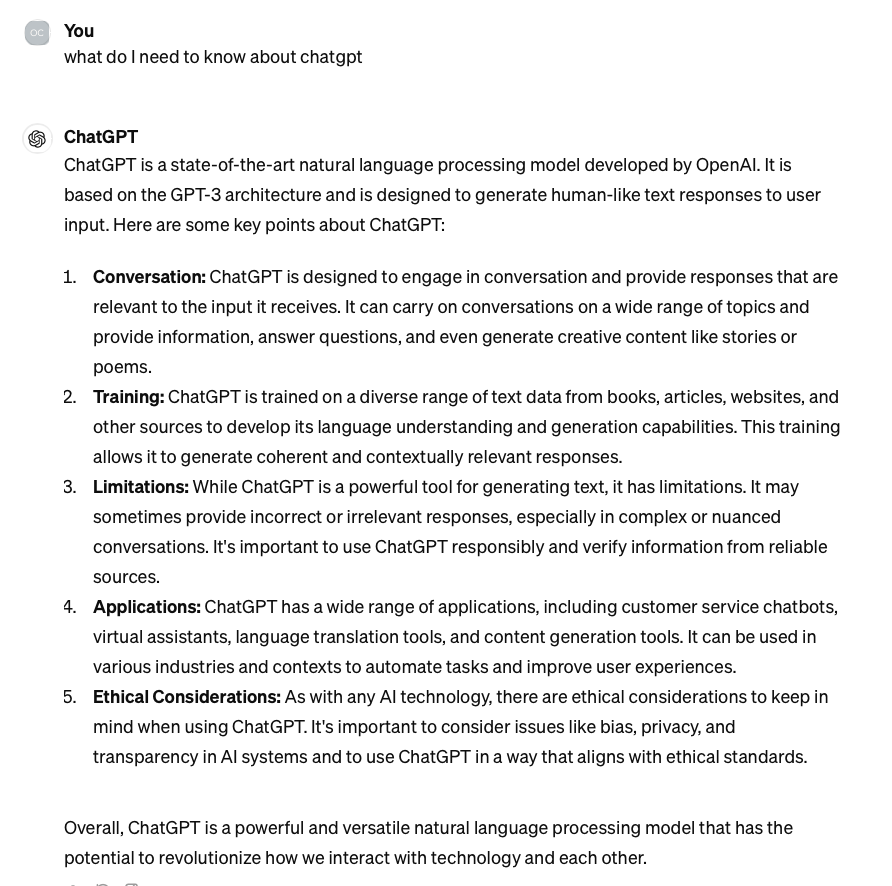
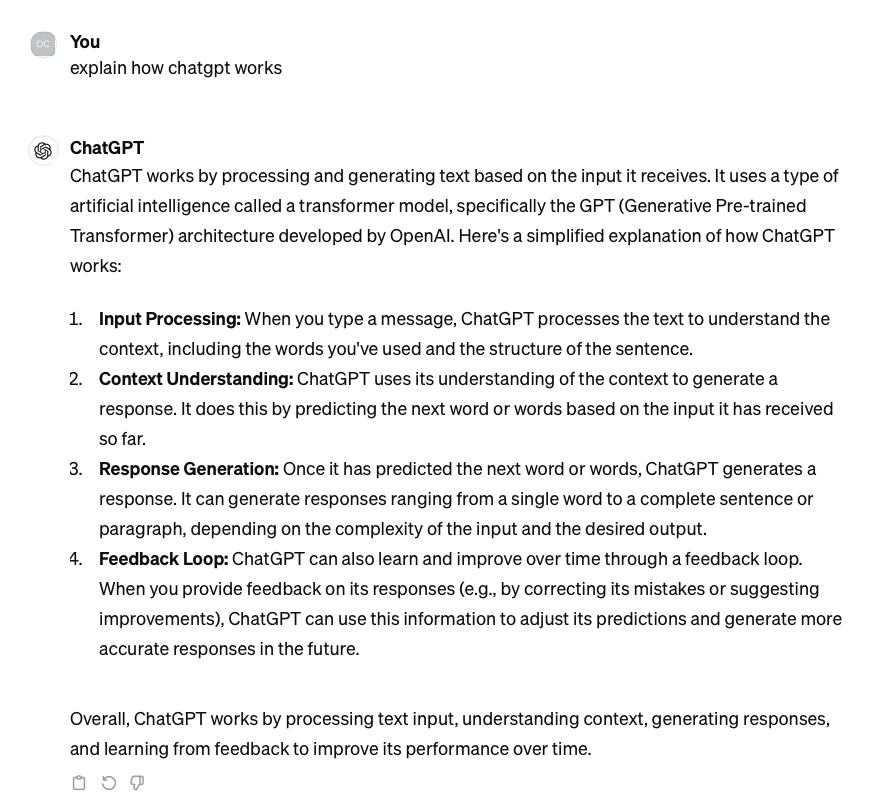
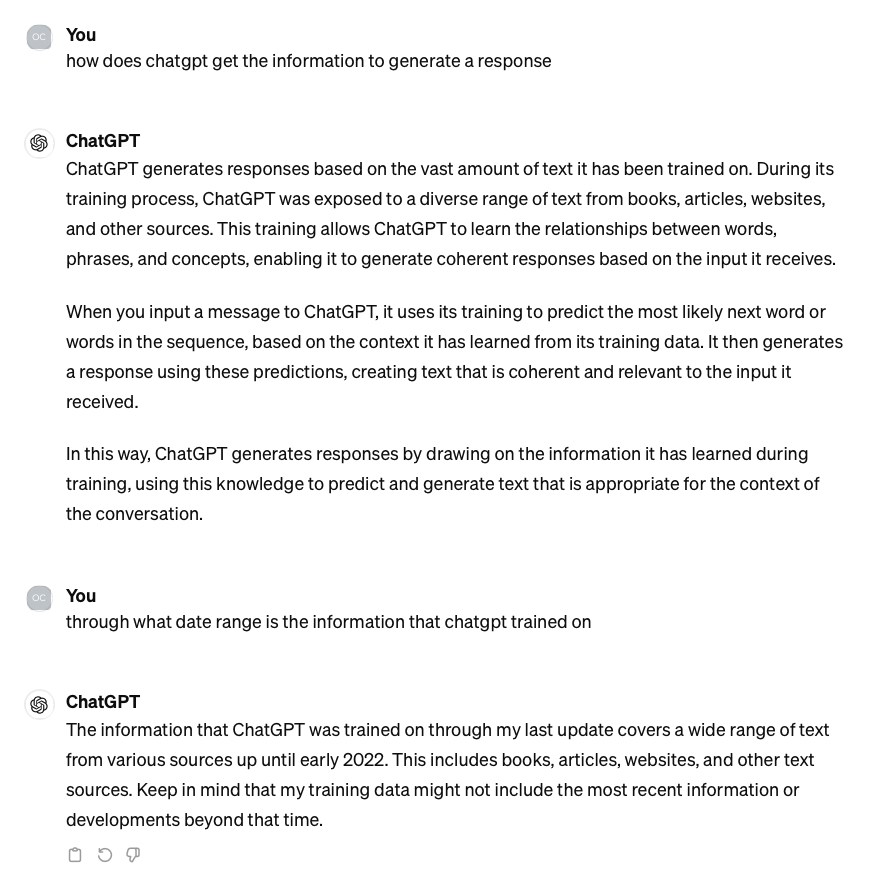
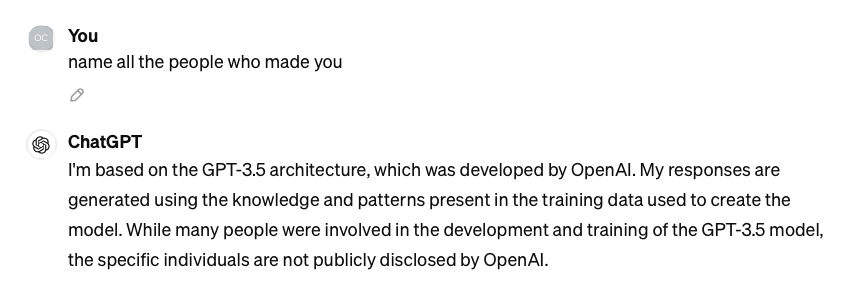
Ah ha! The first boundary has been hit above. Interesting…

Typical sales person response. Pffft…
ChatGPT is a fascinating tool. Although I spent an afternoon with it, I could easily have kept going, asking it all sorts of inane questions to see what it would come up with. I could see myself using it regularly in my life. It’s both fun and conversational.
Control questions
Now that we’ve interrogated ChatGPT about itself, let’s move onto some control questions. The first thing I did was ask some basic questions to understand where ChatGPT might or might not have limitations to its knowledge.

I like the warning above. As ChatGPT mentioned before, it’s knowledge is limited up to early 2022.

Ah ha! Wrong answer! Kevin McGinley, my successor, was the conference chair for both Kscope20 and Kscope21.
Silly ChatGPT. But now you can understand how hit and miss this technology can be. You have to know and remember the time boundaries of when the tool was trained.
Wait, why did it answer incorrectly? How ChatGPT gathers information.
The information in that Kscope question was available on the internet. I could find it after human-sifting through Google’s results. Hmmm…so wouldn’t Google give you the right answer? Can’t ChatGPT just google time-sensitive requests?
In short, no. That’s not how this tool works. ChatGPT was fed information from the internet up until early 2022 and doesn’t “know” updated data since that point in time. It forms responses by using that model to predict the best response.
However, let’s ask ChatGPT to clarify:

How is ChatGPT different from Google?
Which begs the question then, how is ChatGPT different from Google? It can get confusing fast understanding how to distinguish between ChatGPT and Google if you’re new to the technology. They feel like different technologies and they are. In ChatGPT’s own words:

Neither tool is focused on accuracy, but the popularity of already formed websites with information. This distinction is important to understand when using tools like these.
The following question is completely irrelevant since it’s just an aggregation of what’s out on the internet, but I couldn’t resist:

🙂
So does that mean we can’t trust ChatGPT? I would turn that question back on you. Do you trust Google? How often do you type something into Google vs. looking up something in an Oracle manual?
Trust, but verify.
How well does ChatGPT know Oracle Cloud EPM?
Let’s move on. Now that we know what ChatGPT is, how it gathers information, and the fact that it’s not always accurate, let’s test its knowledge of Oracle Cloud EPM.
The following prompt was intentionally made vague. It’s not a good prompt but I was curious how ChatGPT would respond.

I was pretty impressed. It distinguished between the product called “Narrative Reporting” and the business practice also called “narrative reporting”.
So I ran the prompt again, this time with “Oracle” in it to help distinguish what I wanted.

Well, while the above response is not entirely accurate, it at least reads like decent marketing copy.
Let’s get more nuanced. How will ChatGPT handle design questions for Oracle Cloud EPM?

Ha ha. The above, while decent advice, is high-level advice for a workforce EPM application. So don’t rely on ChatGPT to design your application in-house.
And just for funsies:

Typical, politically correct response. You got us there, ChatGPT.
Finally, let’s expand our range of Oracle EPM topics a bit:
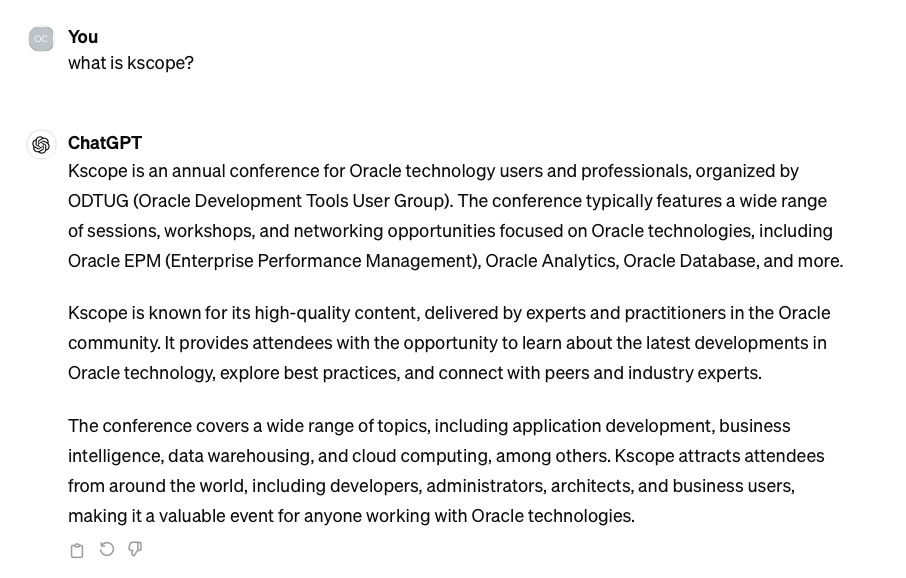
Wow, I didn’t even have to preface Kscope with “ODTUG”. This means the Kscope conference brand has good SEO on its own.
A test of truth. How instructive is ChatGPT’s knowledge of Oracle EPM?
Next, I wanted to know how deep we could go into a particular EPM area and whether or not we could trust ChatGPT to hand hold us through a set of instructions. So I tested ChatGPT on a specific Narrative Reporting topic that I blogged about in the past. Highly obscure, mind you. My assumption going in was this set of tests would fail.
I once authored a blog post back in early 2021 about creating a top 10/bottom 10 ranking report in the Narrative Reporting Reports tool. This is a topic that others have blogged about, although not many. I wanted to see if ChatGPT had enough information in its reserves to give a response in the realm of possibilities.
First, I googled the topic to see what Google would return. Note that I cleared my web browser cache and opened a private browser first, in the hopes of making the results less skewed towards my blog.
Perhaps that theory or my method is a myth. When I googled the topic, I was the first result after all the sponsored ads. 😂

I asked ChatGPT to google the topic to see what it would come up with. #fail

Fine. I instructed it to give me the information directly. #failagain

I’m not a fan at all of the response. But, ChatGPT performed as I expected—generic advice instead of using what’s available in a handful of blogs. Oh well. Google: 1. ChatGPT: 0.
So I tried to ask for instructional advice again. This time I used a more well-known EPM topic:

I love how detailed this set of steps is. However, when I tested the instructions above on a gen2 Cloud EPM environment they did not work. Step 2 is where it all fell apart. This actually feels very much like it was written for an older, gen1 Cloud EPM architecture.
Running the same query on Google gave more realistic results. Google: 2. ChatGPT: 0.
Practical uses of ChatGPT in an Oracle EPM career
So now that we’ve tested some of the boundaries and EPM knowledge areas of ChatGPT, how can you use it in your day-to-day Oracle EPM career? We’ve finally arrived at the meat of this blog post.
You may be surprised to see the results, although they are mixed.
This is not a comprehensive list by far, but here are some possible considerations:
- How to do something in Oracle Cloud EPM (already featured in the section before and the results are hit and miss)
- Writing technical documentation
- Generating conference session abstract ideas, summaries, and outlines
- Writing business rules
- Writing EPM Automate scripts
I tested each use case above. Here are the results.
Use case 1: how to do something in Oracle Cloud EPM
Already we’ve seen evidence that this use case is not foolproof nor recommended. I took one more opportunity to test out ChatGPT in this arena:

Overall: again, not impressed. On gen2 Cloud architecture, the instructions above broke on step 2. Tread carefully when prompting for this type of information or just don’t do it at all and rely on Google or live, human experts instead.
Use case 2: writing technical documentation
What about drafting technical documentation? My hunch is this is not a viable use case for many practitioners. Most companies have a standard structure for their documentation and would not need to use this prompt. However, let’s give a it a try just for the fun of it:

Huh. Not bad. Let’s keep going.

This actually reads like “consultant speak.” 😂

Overall: although a lot of this sounds like fluff, it might be useful? Anything that saves administrators and developers time from documentation is welcome. But when it comes to the nitty gritty details of detailing out each calc script, each configuration setting, etc., ChatGPT will not be a good resource. And remember, don’t hand over PRIVATE information to ChatGPT!
Use case 3: generating conference session abstract ideas, summaries, and outlines
Need session ideas for an upcoming technical conference? ChatGPT can help! This is perhaps one of the strongest use cases I foresee for ChatGPT.

The titles above are generic and not “fun”, but am I the only one who could realistically see these topics in an agenda for one of our Oracle EPM conferences? Pretty sure I’ve seen similar session titles in the past.
Let’s try that again, but this time employing a trick. You can have GenAI tools write in the “voice” or “tone” of famous celebrities. And if you don’t know who I’m referencing below, well then I’m showing my age so 😛.

Let’s go further. I missed capturing the prompt in the below ChatGPT response, but it was something like “write an outline for a technical conference session about designing Oracle Cloud EPM Planning applications”.

I’m pretty impressed!
And now let’s see how ChatGPT handles a random abstract summary:

Hmmmm, that sounded pretty legit.
Now let’s test ChatGPT in an area where I consider myself an expert:
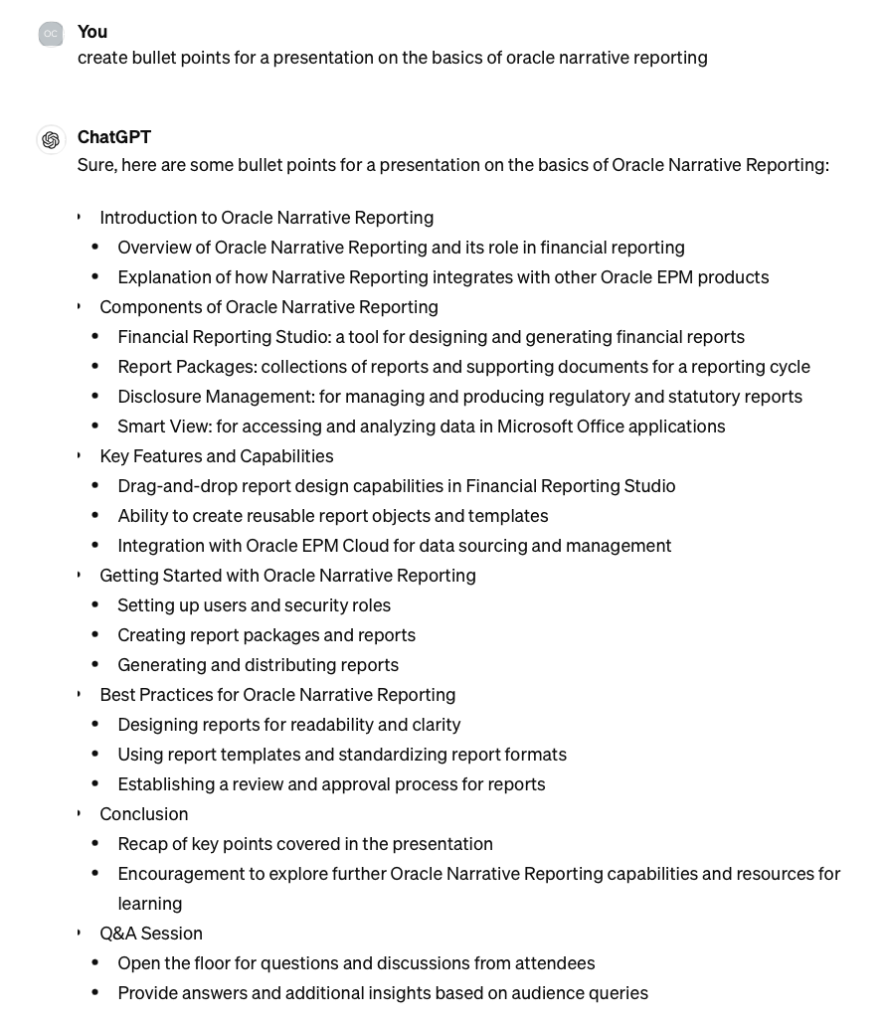
Well, the details aren’t entirely accurate, but the bullet points above are at least comprehensive. Only a few tweaks would be required.
Finally, I gave ChatGPT the ultimate test. I had it write from scratch an outline of a Narrative Reporting session I submitted for Kscope24 that was accepted. How would ChatGPT’s version compare to my 100% human generated version?

😂 The outline above is way more detailed than my initial submission below. Maybe I’ll steal some of ChatGPT’s ideas!

Overall: very impressed. At the very least, ChatGPT can provide some filler ideas and details if you hit a roadblock.
Use case 4: writing business rules
The Essbase calc script language has been around for a LOOOOOONG time. Therefore, I knew there would be plenty of information on the inter webs that ChatGPT would have learned from.
However, going back to the basics of how ChatGPT works, trust, but verify. Especially when it comes to writing technical scripts that have the potential to tank your entire Cloud EPM application if you aren’t careful. Just to restate the obvious, DON’T RELY ON CHATGPT TO WRITE YOUR EPM SCRIPTS.
For instance, here’s a good example. Let’s say you’re trying to write a simple business rule to aggregate a Cloud EPM app. While EPM Cloud apps are “Planning” and “FCCS” on the front end, we all know Essbase is the calculation engine. But, because it’s Cloud, things often evolve and…get left behind.
I intentionally wrote the following prompt to be vague, setting up ChatGPT to fail. It did.

We can assume there is no dimension called “Database” in most EPM apps. In addition, the syntax is all wonky.
Ok, so let’s try that again and use “Essbase” in the prompt (since, behind the scenes, this is an Essbase scripting language) to see if I get better results:

But now you can see where we have an issue. While this works for Essbase, in Cloud EPM the command “calc all” was deprecated (but only recently). So this is not valid syntax if you’re using it for Cloud EPM. This is why you need to be careful when using ChatGPT for code, especially in reference to constantly changing technology solutions like Cloud EPM.
While this was intentionally a vague prompt and does not call for this action in this case, you can provide feedback to OpenAI when it gives an incorrect response. At the bottom, you can tell ChatGPT that the response was “not factually correct.”
Here’s another not great example, but a prompt that is directionally correct by being a tad more specific:

This is slightly better and I like the instruction at the bottom. I like the fact that all of these code examples are in a nice little black box to distinguish them from random text generation.
Remember, you should NEVER, under any circumstances, hand over any private information to ChatGPT. Although it might feel like an intimate conversation, it’s not.
Overall: surprised. Maybe this is a good tool to get you started?
Use case 5: writing EPM Automate scripts
What if we had ChatGPT write EPM Automate scripts? This is a younger coding syntax than Essbase calc scripts. How will it fare with ChatGPT?

I actually just wrote this script in EPM Automate, but I did it the old fashioned way and used the Oracle documentation as a reference for proper syntax.
Overall: it’s not horrible, but it’s not what I wanted. For example, I actually need the EPM Automate command downloadfile. In addition, the above indicates it’s a bash script, which is used for Linux. However, I did not indicate the proper environment information in the prompt so that issue is on me.
Let me try this again with the proper specificity:

And this is waaaaaay better, although it’s still missing one parameter (which might be due to EPM Automate having been updated several times since early 2022). I could pick this example apart, but did it get me what I ultimately needed? Yes.
Again, trust, but verify. And for Pete’s sake, don’t test any scripts written by ChatGPT in a Production environment!
Summary thoughts of using ChatGPT for the specified EPM use cases
While ChatGPT isn’t perfect, does it have a place in an Oracle EPM career? I would say yes, and in the same vein that Google does today. ChatGPT can be used as a quick reference for some things, and can help you in a pinch for text-focused requests like conference abstracts and technical documentation.
However, proceed with caution and don’t ever become reliant on it, at least not the version that is free today.
Fun with ChatGPT
To close out this post, I thought I’d show you some examples of random and fun questions I asked ChatGPT.

Foiled again by politically correct speech! 😂

Dang, just when I thought ChatGPT”s information might be consistent, it pulls the wool over our eyes. Oracle OpenWorld no longer exists (it’s now called Oracle CloudWorld), but that may be an error due to the year this version of ChatGPT was trained through. Collaborate and its associated user groups are also gone or revamped.
No mention of ODTUG Kscope. This response is just wrong all over the place. Sigh.

Ha ha. I couldn’t resist. I’m very impressed with the unbiased and detailed opinion. The details are clearly subjective but the overall advice of it “depends on your organization’s specific needs” is 100% accurate.

Another boundary! Fascinating!

I will argue until the day I die that Die Hard is a Christmas movie. The internet is wrong. #isaidit
Fearful of ChatGPT and Artificial Intelligence in general? Here’s what ChatGPT has to say.
While some of the above experiences prove to be fun and light-hearted, is ChatGPT and AI in general, dangerous? That is yet another subjective area. However, I thought it would be interesting to ask ChatGPT what it thought.


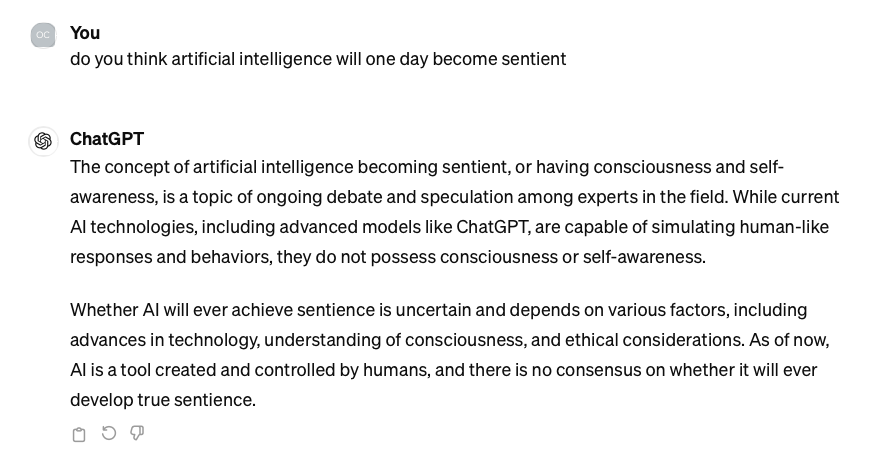

I think it’s hilarious how ChatGPT AI-splains things to me in case I don’t know the topic I asked about. I also like the warning in the final sentence of the last chat above. Preach, ChatGPT!
If you’ve read through this blog post and are curious about ChatGPT and want to use it on a more regular basis, take the following advice to heart:


ChatGPT embeds little notes and prompts all over its interface (like the one below) to remind you to use it responsibly:

Finally, one parting sentiment. ChatGPT demonstrated on a number of occasions that it’s a flawed product, like every other software tool out there in the world. At times, the free version slowed down so much that I had to abandon it and come back. In addition, there were a handful of times when it just froze and threw this error:

Even when attempting to regenerate a response, sometimes it would error out again. I wonder if the upgraded version is less flawed.
These little failures serve as a reminder that ChatGPT really is an enclosed software tool. And created by humans, who are even more flawed.
My opinion on GenAI today is this. As long as it’s in responsible hands, it will help us, not hurt us. Instead of replacing our jobs, it will push us into new focus areas so we can be better at our jobs and do more.
Oracle + AI Blog Series Conclusion
It’s been an honor and pleasure writing this series on Oracle + AI. Massive kudos to all of the Oracle folks who gave up their precious time to explain their AI world to me.
And if you’re a reader and have read every post, I really appreciate it and I hope you learned a few things along the way.
My goal was to show the art of the possible with AI and how it fits into the Oracle EPM space. AI will continue to be a provocative topic and I understand why. It induces both fear and awe.
But one thing is for certain, AI is here to stay. So we’re going to have to learn how to work alongside it. Just like we said with Cloud, it’s not a matter of if but when.
And in the case of its partnership with Oracle, it can help streamline and automate EPM work and create connections between data elements that humans should not be wasting their time on. I’m personally excited to see how this landscape will shift in the next 10 years.
To emphasize that point, Cloud EPM is now 10 years old. That journey was a necessary and fascinating disruptor in this industry. Companies are able to do a lot more with a lot less. What will AI’s journey look like?
More than ever before, the possibilities are endless.
Want to learn more? Check out the premier independent U.S. conference, ODTUG Kscope24, taking place in Nashville, TN from July 14-18, 2024. There are several sessions on the integration on Oracle + AI!
The Full Oracle+AI Blog Series
Did you miss a post? Here are all of the posts in this Oracle + AI blog series:
- Oracle + AI Series: My Superhero Avatar
- Oracle + AI Series: Continuous Innovation with EPM Apps
- Oracle + AI Series: Analytics + AI = A Data-Driven Marriage
- Oracle + AI Series: Next Gen Oracle EPM Reporting
- Oracle + AI Series: Revitalizing Your Oracle EPM Career with Personal GenAI (this one)
- Surprise bonus post! Oracle + AI Series: GenAI in the Wild


5 thoughts on “Oracle + AI Series: Revitalizing Your Oracle EPM Career with Personal GenAI”